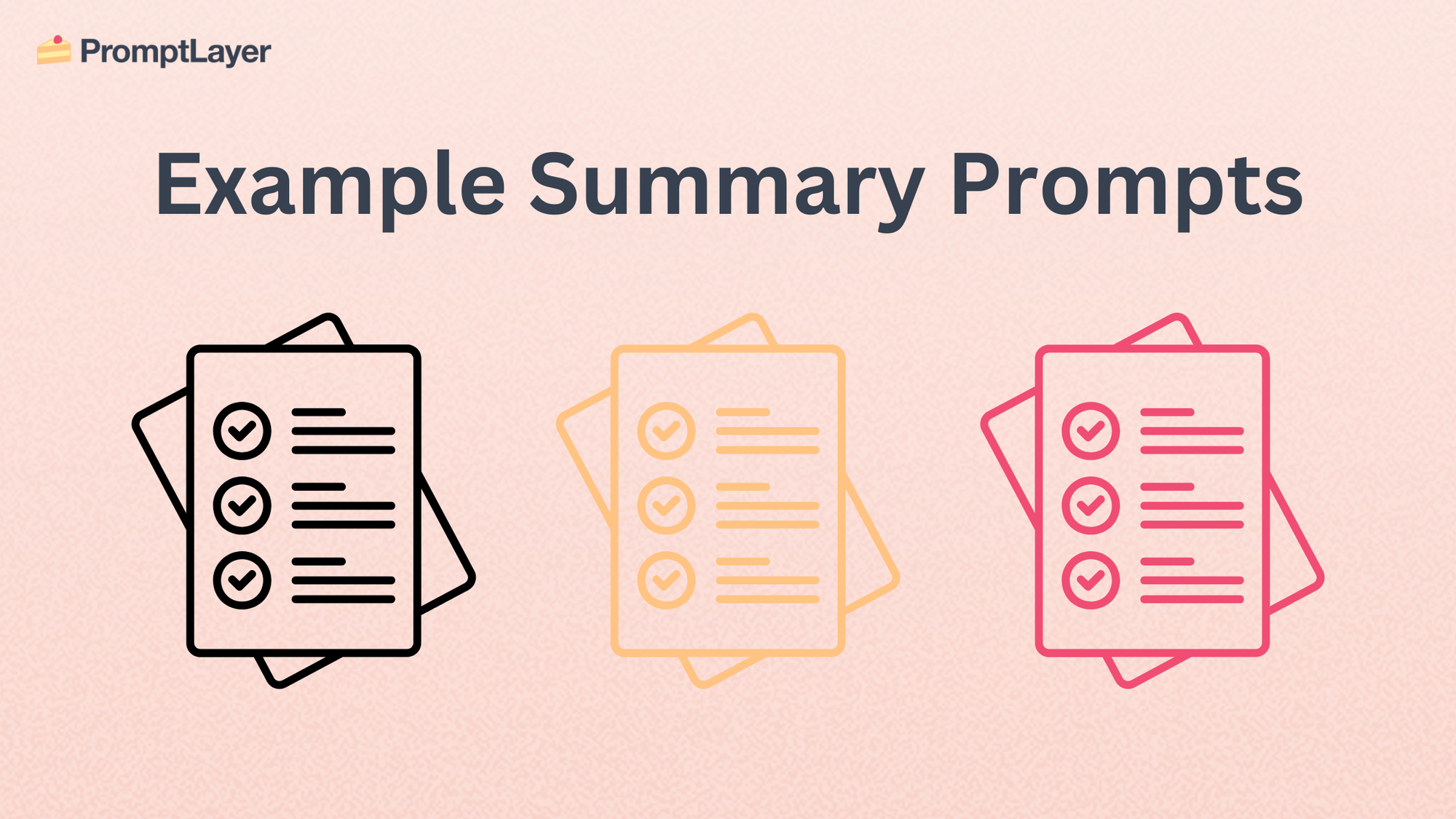Best Prompts for Asking a Summary: A Guide to Effective AI Summarization

Table of contents:
- What Are AI Summary Prompts?
- Five Types of Effective Summary Prompts
- Best prompts asking for a summary | Six Examples
- Avoiding Common Mistakes in AI Summarization
- Evaluating Your AI-Generated Summaries
- Tips for Combining AI with Your Unique Voice
Summarization is a key skill in our information-dense world, and leveraging AI can take your abilities to the next level. Whether you’re condensing a research paper, simplifying technical jargon, or creating an executive overview, the right AI prompt can make all the difference.
Generative AI (gen AI) tools like ChatGPT, Claude, and Gemini excel at summarizing texts effectively—provided you guide them correctly. Here’s how to craft impactful prompts, avoid common pitfalls, and refine summaries to meet your needs.
What Are AI Summary Prompts?
AI summary prompts are instructions you provide to an AI tool to guide it in creating concise, clear, and meaningful summaries of text. The quality of the output depends on how well the prompt communicates your expectations. You can use summary prompts for various purposes, such as extracting key points from long articles, creating digestible bullet points, or tailoring content for specific audiences.
Generative AI’s capabilities have advanced significantly, enabling it to produce precise and targeted summaries. However, achieving optimal results requires a strategic approach to prompt design.
Looking to embed smart, API-driven agents into your apps? PromptLayer lets you design, deploy, and monitor AI agents in minutes. No backend headaches required.
- Drag-and-drop workflow builder for chaining multiple LLM calls, business rules, and API integrations visually
- Versioned Prompt Registry to track, compare, and roll back prompt iterations effortlessly
- Real-time observability & alerts on token usage, latency, failures, and cost spikes
- Collaborative workspaces with role-based access controls and inline reviews for seamless team collaboration
Try PromptLayer free and start building production-ready AI agents today!
Five Types of Effective Summary Prompts
To get the most from AI tools, you need to understand the different types of summary prompts and how to use them effectively:
- Zero-Shot Prompting: This straightforward approach uses the AI’s pre-trained knowledge without any additional context. For instance, a prompt like, “Summarize the following text in one paragraph” works well for general purposes. However, this method may lack precision for complex or nuanced material.
- Few-Shot Prompting: Enhance accuracy by providing examples. For instance, include multiple text-summary pairs before your target text. Example: “Example 1: [Text 1] Summary: [Summary 1]. Now summarize this text: [Text 2].” Few-shot prompting helps align the AI’s tone and focus with your expectations.
- Chain-of-Thought Prompting: Encourage the AI to articulate its reasoning before generating the final summary. For example, “Explain your reasoning step-by-step and then summarize the text in three sentences.” This is particularly useful for academic or technical texts.
- Role-Playing Prompting: Assign a role to the AI for summaries with specific tones or audiences. Examples include: “As a teacher, summarize this text for a 7th-grade audience,” or “As a business analyst, create an executive summary.” This guides the AI’s perspective and language.
- Instruction-Based Prompting: Specify your requirements explicitly. For example: “Provide a bullet-point summary of the main arguments in under 50 words,” or “Summarize this document in two sentences, focusing on ethical implications.” Clear instructions ensure precise outcomes.
Best prompts asking for a summary | Six Examples
1. General Summary with Clarity and Brevity
Prompt:
"Summarize the following text in one clear and concise paragraph, capturing the key ideas without missing critical points. Ensure the summary is easy to understand and avoids excessive detail."
Aim:
To produce a straightforward summary that distills the main ideas of a text into a single, well-structured paragraph.
2. Audience-Specific Summary
Prompt:
"As a teacher explaining to a high school audience, summarize the following text. Use simple language and examples to make the key ideas accessible for students with no prior knowledge of the topic."
Aim:
To tailor the summary to a specific audience by adjusting tone, vocabulary, and complexity.
3. Format-Specific, Bullet-Point Summary
Prompt:
"Provide a bullet-point summary of the following document, listing the main arguments and supporting evidence in 5–7 concise bullet points. Avoid unnecessary detail and focus on the most important takeaways."
Aim:
To condense the text into a structured format that highlights key points in an easily digestible list.
4. Role-Specific Executive Summary
Prompt:
"As a business analyst, create an executive summary of the following report. Focus on the key insights, actionable recommendations, and any data points relevant for decision-making. Keep the summary under 150 words."
Aim:
To produce a professional summary focused on actionable insights for a business audience.
5. Chain-of-Thought Summary for Complex Topics
Prompt:
"Step-by-step, identify the main points of the following academic article, explaining their significance as you go. Then, summarize the entire text in three sentences, focusing on the key findings and their implications."
Aim:
To encourage the AI to reason through the text systematically before delivering a concise summary, improving accuracy for complex material.
6. Length-Specific, Ultra-Condensed Summary
Prompt:
"Condense this article into a 25-word summary that captures the core message and most important takeaways. Avoid technical jargon and prioritize simplicity."
Aim:
To create a highly concise summary that focuses on the essence of the text, ideal for quick overviews or summaries for social media posts.
Avoiding Common Mistakes in AI Summarization
When working with AI, it’s crucial to avoid:
- Overloading the Summary: Too much detail defeats the purpose of summarization.
- Vagueness: Ensure the summary captures the text’s essence clearly.
- Copy-Pasting Verbatim: Summaries should paraphrase rather than replicate.
- Missing Key Points: Balance brevity with thoroughness.
- Inconsistent Tone: Match the summary’s tone to the intended audience.
Evaluating Your AI-Generated Summaries
To ensure quality, assess the summary based on:
- Accuracy: Does it reflect the original text’s main points?
- Clarity: Is the language straightforward and easy to understand?
- Completeness: Does it include all critical information?
- Brevity: Is it concise without omitting key ideas?
- Relevance: Does it address the needs of the intended audience?
Tips for Combining AI with Your Unique Voice
While AI can enhance your summarization skills, retaining your personal touch is important. Here’s how:
- Customize Your Prompts: Include details about tone, style, or audience to align AI outputs with your preferences.
- Edit the AI’s Work: Use AI-generated summaries as a starting point, refining them to ensure consistency with your voice.
- Mix and Match: Incorporate only the most helpful AI suggestions while relying on your judgment for the final product.
Conclusion
Mastering AI prompts for summarization unlocks new levels of efficiency and clarity. By understanding different prompt types, tailoring your instructions, and critically evaluating the results, you can craft summaries that effectively communicate complex ideas in a concise manner. Embrace AI as a powerful tool, but remember to infuse your unique perspective to create summaries that resonate with your audience.
About PromptLayer
PromptLayer is a prompt management system that helps you iterate on prompts faster — further speeding up the development cycle! Use their prompt CMS to update a prompt, run evaluations, and deploy it to production in minutes. Check them out here. 🍰



